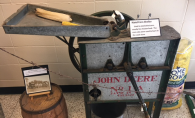There’s a little door on the south side of the Maple Grove Public Works building. Inside, Roger McHugh and a group of elder statesman of Maple Grove have created a treasure trove of city history. One of the exhibits McHugh created is a history and timeline of the one-room schoolhouses that were scattered throughout the area.
Before Osseo and Maple Grove moved together into the current larger school district, students were sent to the nearest schoolhouse. In Maple Grove, these houses included Eagle Lake School, Weaver Lake School, Fish Lake School, and Hennessey Hill School. Beginning in the late 1800s all the way up to the 1950s, students would often attend the same school for a majority of their education.
Carol Emmans is a retired teacher who attended the Weaver Lake School located on Dunkirk and 89th in Maple Grove. The school was one room, with about 15-20 total students ranging from first to eighth grade. “You listened to the other classes, and by the time I got to fourth grade, I almost knew the reading book by heart,” Emmans says.
The description of this schoolhouse sounds like something straight out of Little House on the Prairie. Everything you might imagine about the lore of a one-room school is confirmed by talking to the people who grew up there.
Inside the schoolhouse there was an oil burner in the corner that the teacher would light in the morning to provide heat throughout the day. Students sat with other members of their grade (although there weren’t necessarily students in each grade). The teacher sat at the front of the room, with the students in front of her, each having their own desk where they kept their belongings. Throughout the day, the teacher would take turns working with students from each grade; in between, students would complete the lesson plans assigned on the chalkboard.
Aside from the large main room, there was a small coatroom, and room to store lunches. A hot lunch consisted of setting a jar brought from home on a small burner so that by the time lunch rolled around it would be warm enough to eat.
Outside was a pump for water and separate outhouses for the boys and the girls, divided by a woodshed. “It was a big thing when the boys went into the woodshed and looked through the cracks into the girls’ outhouse,” Emmans laughs.
Most of these schoolhouses began closing in the 1950s. Weaver Lake closed in 1953, and was eventually converted into a private residence, which still stands today. Other schoolhouses have been converted into businesses, such as the first schoolhouse, called Maple Grove School, which is now the Osseo Alcoholics Anonymous building. Some of them were torn down. Two were destroyed by fires. The original Eagle Lake School burned down in 1932, but was rebuilt the following year and now stands as a private residence.
Inside the Maple Grove History Museum, Roger McHugh leads visitors through the exhibit he created. Although he did not attend any of the schoolhouses himself, he takes pride in the rich history of Maple Grove and in keeping it alive for generations to come.
&
The Maple Grove History Museum is open on the second Sunday of each month from 1-4 p.m.
9030 Forestview Lane N. (south driveway)









